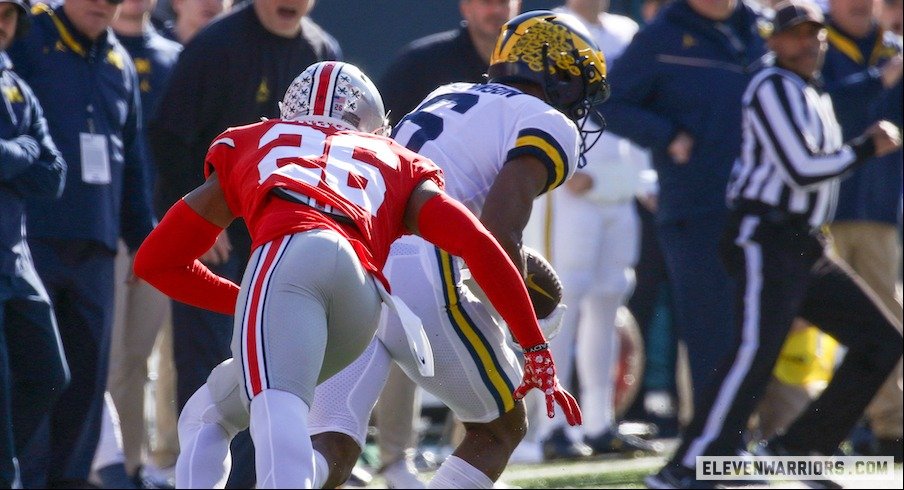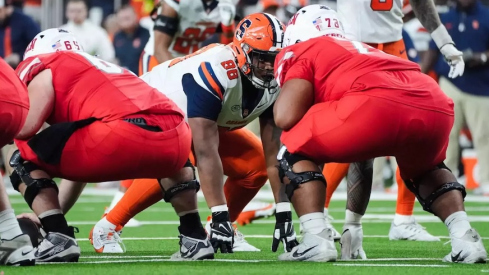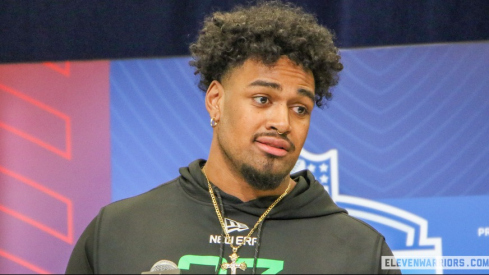While Michigan scored nearly twice as many points as Ohio State on Saturday, the Buckeyes had their chances to win this year’s edition of The Game.
Ohio State looked like the better team for most of the first half, and the Wolverines never led by more than four points until the fourth quarter. In fact, Ohio State actually had a higher net success rate on a play-to-play basis than Michigan did throughout the game.
Did We Really Get Beat that Bad?
— parker, u n v e r i f i e d (@statsowar) November 28, 2022
Net Success Rates Week 13
Colorado, Rutgers, Miami, Wyoming, Washington State, Northern Illinois, Baylor, Coastal Carolina, Arkansas State, Hawai'i, Texas State, Stanford, Bowling Green, and Auburn: y'all really did get beat that bad. pic.twitter.com/VkVSuf6ZNq
However, the Buckeyes let Michigan hang around early, and a game that began to snowball in Michigan’s favor late in the first half eventually turned into an avalanche late in the second half as the road team won 45-23.
How did a game that looked plenty winnable for the Buckeyes end up being a decisive victory for their rivals? We identified 12 plays that swung the game away from Ohio State – or could have swung the game in the Buckeyes’ favor – and how they turned what was supposed to be a revenge win for the Buckeyes into their second straight loss to the team up north.
Q2, 15:00: McCalister misses a pick off a deflection
This may not have been the most consequential play in The Game, but it’s an example of a missed opportunity that could have enabled Ohio State to build a commanding early lead instead of letting Michigan hang around.
Had Ohio State safety Tanner McCalister kept his balance on Ronnie Bell’s break back to the ball, he likely would have been in position to intercept this 3rd-and-5 pass after it went off Bell’s hands. Had McCalister caught the ball, he would have green grass in front of him to potentially run the ball back for a pick-six and give the Buckeyes a 17-3 lead – or at a minimum, give Ohio State prime field position to take a two-score lead, which the home team never did.
Q2, 11:37: Stover can’t make catch on 4th-and-2
BIG BLUE STOP @jayharrell32 x @UMichFootball pic.twitter.com/Qv5BYuAHcV
— FOX College Football (@CFBONFOX) November 26, 2022
After driving to the 34-yard line on its subsequent possession after a Michigan punt, Ohio State opted to go for it on 4th-and-2 – a logical decision considering Noah Ruggles has never made a 50-plus-yard field goal in his college career. The play call on Ohio State’s fourth-down conversion attempt, however, was more questionable.
Rather than running the ball or drawing up a play for one of its star receivers, Ohio State took all of Marvin Harrison Jr., Emeka Egbuka and Julian Fleming off the field in favor of a three-tight end set featuring Xavier Johnson as the only wideout. That attempt to fool Michigan into committing to the run didn’t work, as Wolverines defensive end Jaylen Harrell effectively covered Cade Stover downfield and Stover was unable to haul in a deep pass from C.J. Stroud, leaving another opportunity for the Buckeyes to take a two-score lead on the table.
Q2, 7:39: Cornelius Johnson breaks free for a 69-yard TD
TOUCHDOWN @UMichFootball @CorneliusNation x @jjmccarthy09 pic.twitter.com/uWtoKRVIcg
— FOX College Football (@CFBONFOX) November 26, 2022
Going into this play, Ohio State’s defense had a chance to achieve its third straight 3-and-out. Instead, the Buckeyes allowed Michigan to score its first touchdown and tie the game at 10-10 with a truly game-changing play.
Jim Knowles made an aggressive call by putting all 11 of Ohio State’s defenders within six yards of the line of scrimmage, and that aggression backfired in a big way when J.J. McCarthy stood in the face of the heavy blitz and completed a pass to Cornelius Johnson. When Cameron Brown missed a tackle on Johnson after the catch, the only player who had any chance of catching the Michigan wideout was Jack Sawyer – and that’s a tough play to expect an edge defender to make.
Q2, 5:24: Johnson burns Buckeyes again for 75-yard TD
75 YARDS DEEP TO THE ENDZONE!! @jjmccarthy09 x @CorneliusNation x @UMichFootball pic.twitter.com/J30m0J2QQv
— FOX College Football (@CFBONFOX) November 26, 2022
After a Ruggles field goal, Michigan took the lead (17-13) on its very next offensive play with another long touchdown catch by Johnson. This time, it was simply a coverage bust, as Cameron Martinez got turned around and allowed Johnson to get wide open over the middle, giving him a clear path to stroll into the end zone for a 75-yard score.
That was the only time in the game where Ohio State had its base defense on the field with a backup safety in the game – Martinez in place of McCalister – and that rotation backfired immediately. And much like on the previous touchdown, Knowles did not leave anyone deep to serve as a last line of defense, giving the Buckeyes no chance of catching Johnson once Martinez got beat.
Q3, 13:27: Michigan converts 4th-and-1 at own 34-yard line
Blink and you might have missed it – FOX never even showed full-screen video of the play – but this play was a crucial start to Michigan’s second-half takeover of The Game.
Ohio State had a 20-17 lead coming out of halftime after a 42-yard touchdown pass from Stroud to Harrison and forcing Michigan to punt on its final two possessions of the first half, and the Buckeyes would have gotten the ball back well within Michigan territory if this fourth-down conversion attempt had been unsuccessful. It was a roll of the dice by Jim Harbaugh to go for it on 4th-and-1 at the Wolverines’ 34-yard line, but that gamble paid off as Donovan Edwards ran for a 2-yard gain, ultimately setting up what would be the final lead change of the game three plays later.
Q3, 12:06: Another coverage bust allows 45-yard TD
ANOTHER BIG PLAY FOR THE TOUCHDOWN! @UMichFootball @colstonlovelan1 x @jjmccarthy09 pic.twitter.com/N5nlJ7ejbz
— FOX College Football (@CFBONFOX) November 26, 2022
With Michigan facing 1st-and-10 at Ohio State’s 45-yard line, Knowles again relied on his defensive backs to play man-to-man coverage with every defender in a box within 10 yards of the line of scrimmage.
Knowles paid the price for that again as Ransom got caught with his eyes looking back to the quarterback, allowing Loveland to separate from him for a deep-ball touchdown catch that made the score 24-20 and gave Michigan a lead it would not relinquish for the remainder of the game.
Q3, 8:03: Buckeyes lose 25 penalty yards on same play
Ohio State got the ball at Michigan’s 48-yard line with a chance to take the retake lead after the defense forced a 3-and-out and Brad Robbins’ subsequent punt went only 33 yards. The Buckeyes immediately squandered that field position away when they committed two penalties on their first play of the possession.
Donovan Jackson was flagged for holding. More unacceptably, Gee Scott Jr. drew an unsportsmanlike conduct penalty for headbutting Michigan safety Rod Moore. Those two infractions totaled 25 penalty yards and nullified a 24-yard catch-and-run by Chip Trayanum – a 49-yard swing that brought the Buckeyes back inside their own 30-yard line rather than inside Michigan’s 25.
Q3, 6:10: Errant long snap kills fake punt attempt
After recovering from the penalties to get it back to 4th-and-5, Ohio State had to decide whether to go from it from Michigan’s 43-yard line. Initially, it appeared as though Ryan Day chose to be conservative, as the Buckeyes opted to punt the ball away rather than leave their offense on the field – a decision Stroud could be seen visibly disagreeing with.
As it turned out, the Buckeyes had a fake punt drawn up, but they didn’t end up executing it. First, Mason Arnold was flagged for an illegal snap penalty, which turned 4th-and-5 into 4th-and-10. On the subsequent snap, Arnold – in just his fifth game as Ohio State’s starting long snapper following Bradley Robinson’s season-ending knee injury – snapped the ball to Jesse Mirco even though it appeared the ball was supposed to go to Mitch Rossi, who would have had an open lane to run through for a potential fourth-down conversion.
Even Harbaugh acknowledged the Buckeyes left points on the table with that miscue, as he said Michigan “got extremely lucky” the fake punt wasn’t executed and “it would have been a huge gain.”
Q3, 2:37: Michigan converts 3rd-and-1 with trick play
WHAT A PLAY! @UMichFootball @kalelmullings with the pass! pic.twitter.com/QzzO8Y2gpZ
— FOX College Football (@CFBONFOX) November 26, 2022
Michigan began to seize full control of the game on its final drive of the third quarter, on which the Wolverines had four third-down conversions and took 7:50 off the clock en route to scoring a touchdown that extended their lead to 11 points. The first of those four third-down conversions involved the Wolverines dipping into their own bag of tricks.
With Michigan facing 3rd-and-1 at the 38-yard line, Ohio State sold out to stop the run by putting all 11 defenders in the box, looking to force Michigan into a long field goal attempt or punt. The Wolverines identified that as the perfect time to have running back Kalel Mullings throw a surprise pass to tight end Luke Schoonmaker, and the trick play worked for a 15-yard gain as Michigan used Ohio State’s aggressiveness against it once again.
Q4, 14:10: Hickman commits pass interference in red zone
Pass interference! Puts the Wolverines on the 2-yard line! pic.twitter.com/RdD4IBfuoh
— FOX College Football (@CFBONFOX) November 26, 2022
Despite giving up the trick play, Ohio State had another opportunity to limit Michigan to three points later in the drive when the Wolverines faced 3rd-and-10 at the 13-yard line. Initially, it appeared as though the Buckeyes’ third-down pass defense was successful, as JT Tuimoloau, Zach Harrison and Mike Hall all brought pressure that forced McCarthy to heave a throw off his back foot that fell incomplete.
Ohio State was penalized for pass interference, however, when Ronnie Hickman ran into Bell, preventing Bell from making a play on the ball. That penalty moved the ball to the 3-yard line, setting up a McCarthy touchdown run that would give Michigan the first two-score lead of the game.
Q4, 7:35: Mike Sainristil breaks up TD pass to Stover
BIG defensive save by @MikeSainristil for @UMichFootball! pic.twitter.com/DWMOSwBuE4
— FOX College Football (@CFBONFOX) November 26, 2022
A 44-yard completion from Stroud to Egbuka – the longest offensive play of the day for Ohio State – gave the Buckeyes their best chance to score a touchdown in the second half. They’d end up settling for a field goal after an unsuccessful third-down pass attempt from the 9-yard line.
Much like on the fourth-down conversion attempt earlier in the game, Ohio State opted to put multiple tight ends in the game and draw up a play for Stover. The Buckeye tight end got open this time, but Michigan defensive tackle Kris Jenkins beat Jackson on a pass rush to put pressure on Stroud, forcing him to throw off his back foot. Stroud’s throw hung in the air a bit longer than it should have as a result, allowing Michigan cornerback Mike Sainristil to catch up to Stover and knock the ball out of his grasp.
Q4, 7:23: Edwards runs for a 75-yard touchdown
RUN, DONOVAN, RUN @UMichFootball TOUCHDOWN! @DEdwards__ x @jjmccarthy09 pic.twitter.com/lnNOM05IBp
— FOX College Football (@CFBONFOX) November 26, 2022
Even after settling for the field goal, Ohio State had a chance to tie the game on its next possession if it could get a defensive stop. Instead, it took only one play for Michigan to land what would prove to be the knockout blow.
Michigan’s center and right guard both stuck blocks on Ohio State linebackers Tommy Eichenberg and Steele Chambers, opening a wide hole for Edwards to run through. The only unblocked Buckeye with a chance to make play on Edwards was Ransom, and the single-high safety was a step slow to react. Edwards ran right past Ransom and went all the way to the end zone for a 75-yard touchdown.
Facing 3rd-and-10 with Ohio State in desperate need of a touchdown on its next possession, Stroud was intercepted while attempting to pitch a pass to Xavier Johnson under pressure.
INTERCEPTION @UMichFootball defensive coming up BIG!!! pic.twitter.com/djy8wu2UOu
— FOX College Football (@CFBONFOX) November 26, 2022
Edwards subsequently drove the final dagger through the Buckeyes’ heart when he ran for an 85-yard touchdown just three plays later. With just 3:19 left on the clock and Ohio State desperately needing a stop on 3rd-and-3, the Buckeyes stacked the box only for Edwards to get a wide lane between the center and right guard again, and Ohio State had no chance of catching the Michigan running back once he hit the hole, giving the Wolverines an insurmountable 22-point lead.
MICHIGAN IN STRIDE!! @UMichFootball
— FOX College Football (@CFBONFOX) November 26, 2022
ANOTHER TOUCHDOWN FOR THE WOLVERINES BY @DEdwards__ ! pic.twitter.com/t719GaUKir
By the time those two plays happened, though, the game had already turned. Even without Edwards’ second touchdown run, Ohio State would have needed two touchdowns and a two-point conversion in the final seven minutes of the game to tie it up – and the Buckeyes simply weren’t playing well enough on either side of the ball to make that comeback happen.
If even a few of the plays above had gone differently, it could have been a very different game and Ohio State would have at least had a chance to win. But missed opportunities by the Buckeyes and big plays with the Wolverines made The Game a more lopsided victory for Michigan than it ever should have been.


